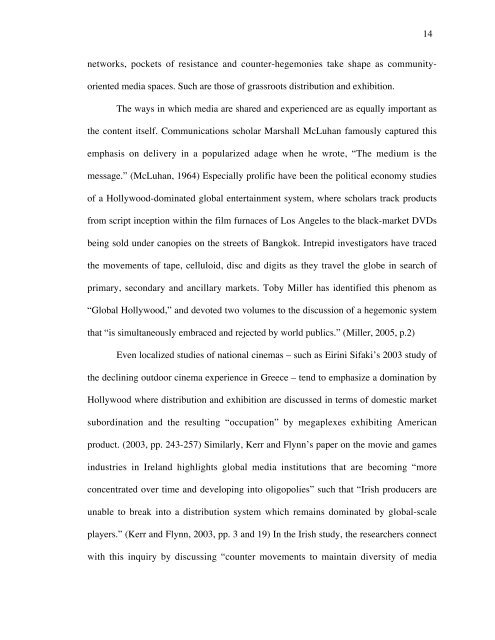The Spaces Between Grassroots Documentary ... - Ezra Winton
The Spaces Between Grassroots Documentary ... - Ezra Winton
The Spaces Between Grassroots Documentary ... - Ezra Winton
Create successful ePaper yourself
Turn your PDF publications into a flip-book with our unique Google optimized e-Paper software.
networks, pockets of resistance and counter-hegemonies take shape as community-<br />
oriented media spaces. Such are those of grassroots distribution and exhibition.<br />
<strong>The</strong> ways in which media are shared and experienced are as equally important as<br />
the content itself. Communications scholar Marshall McLuhan famously captured this<br />
emphasis on delivery in a popularized adage when he wrote, “<strong>The</strong> medium is the<br />
message.” (McLuhan, 1964) Especially prolific have been the political economy studies<br />
of a Hollywood-dominated global entertainment system, where scholars track products<br />
from script inception within the film furnaces of Los Angeles to the black-market DVDs<br />
being sold under canopies on the streets of Bangkok. Intrepid investigators have traced<br />
the movements of tape, celluloid, disc and digits as they travel the globe in search of<br />
primary, secondary and ancillary markets. Toby Miller has identified this phenom as<br />
“Global Hollywood,” and devoted two volumes to the discussion of a hegemonic system<br />
that “is simultaneously embraced and rejected by world publics.” (Miller, 2005, p.2)<br />
Even localized studies of national cinemas – such as Eirini Sifaki’s 2003 study of<br />
the declining outdoor cinema experience in Greece – tend to emphasize a domination by<br />
Hollywood where distribution and exhibition are discussed in terms of domestic market<br />
subordination and the resulting “occupation” by megaplexes exhibiting American<br />
product. (2003, pp. 243-257) Similarly, Kerr and Flynn’s paper on the movie and games<br />
industries in Ireland highlights global media institutions that are becoming “more<br />
concentrated over time and developing into oligopolies” such that “Irish producers are<br />
unable to break into a distribution system which remains dominated by global-scale<br />
players.” (Kerr and Flynn, 2003, pp. 3 and 19) In the Irish study, the researchers connect<br />
with this inquiry by discussing “counter movements to maintain diversity of media<br />
14


